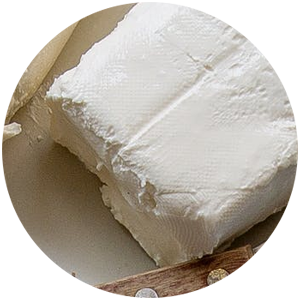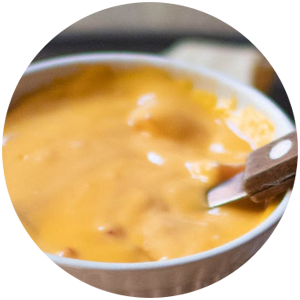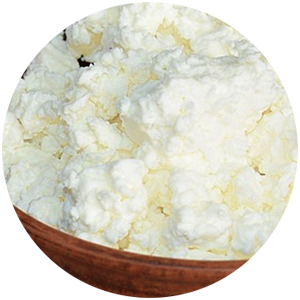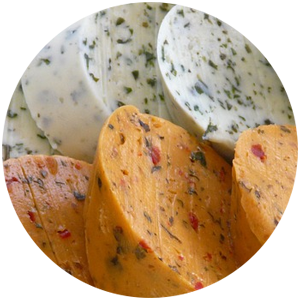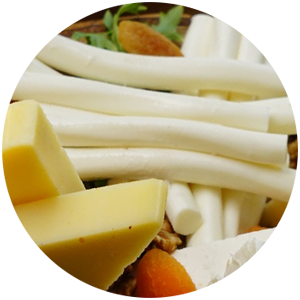Cottage cheese and creamed cottage cheese
These types of cheese fall into the category of unripened cheeses. Cottage cheese itself is a soft and coagulated curd cheese, while creamed cottage cheese is basically a cottage cheese covered with a creaming mixture. There are three recommended food additives: Sodium Carboxymethyl Cellulose (CMC), Monoglycerides (DMG) and Xanthan Gum (XT). The use of CMC and DMG is regulated by Good Manufacturing Practice (GMP). CMC controls various parameters including mouthfeel, chewiness and texture. Xanthan Gum 0.5% solution Xanthan thickens cottage cheese dressings by providing good drainage control. In addition, Xanthan Gum improves consistency and reduces the volume in sour cream.
Cream cheese with or without ingredients
Cream cheeses are uncured, soft spreadable and also considered to be unripened. Usually, a combination of XT 0.5% solution and CMC 0.5% solution replaces the basic resource of milk fat and allows prepare functional low-fat cream cheese. The researches show that with the fat level decrease, moisture and protein content increase, while pH value does not change. Being mixed with other gums, XT can also improve firmness and flavor perception in cream cheese.Cream cheese spread with or without ingredients and processed cheese spread with or without ingredients
Spreadable cheeses vary a lot not only in the cheese type (we all know Dutch cheese spread, beer cheese spread, etc.) but for the variety of ingredients in it as well. Similar to the impact on cream cheese, XT 0.5% solution improves the firmness, flavor and other texture characteristics of cream cheese spread and processed cheese spread. The higher concentration of XT controls the hardness, adhesiveness, cohesiveness, springiness, gumminess, chewiness. As a texturizer, CMC 0.5% solution is usually added to the spreads. 3.5% solution of Sodium Acid Pyrophosphate (SAPP) or Sodium Hexametaphosphate (SHMP) is recommended as an emulsifier for pasteurized processed cheese spread. Sodium Gluconate 4.0% solution can be optionally added as an emulsifying and stabilizing agent.
Processed cheese with or without ingredients and processed cheese food with or without ingredients
Precessed cheese is widely consumed due to its heat resisting ability and longer shelf-life and it is vastly produced on an industrial scale. Its numerous varieties require different solutions and food additives to achieve the desired effect. For example, CMC 0.5% solution is used as a thickening agent and to make cheese smoother. SAPP (3.5% solution) is used as an emulsifying agent to produce hard texture and ensure lower meltability. DMG (0.5% solution) controls the melting properties and improves texture control as well. Sodium Gluconate (4.0% solution) is helpful as it prevents the formation of lactate crystals. These crystals are usually a production defect on an industrial scale, that is why Sodium Gluconate is added at the first production steps (the salting step). Another advantage is slightly improved smoothness and odor. SHMP (3.5% solution) is used as an emulsifier. It improves the protein’s swelling capacity and prevents the leakage of water or fat. At the same time, SHMP can lower the meltability and increase the hardness, basically allowing to control not only the nutritional value but the texture and melting properties of processed cheese as well.Cold-pack cheese food with or without ingredients
This cheese is also known under the names of club cheese, comminuted cheese, or crock cheese. It is produced by blending two or more varieties of natural cheese without thermal processing or heating. Thus, XT 0.5% solution and CMC 0.5% solution is recommended for better texture and mouthfeel of cold-packed cheeses. The effect of adding XT and CMC is also similar to the one in the cream cheese manufacturing process.The mentioned solutions are the maximum level of use and should be applied in accordance with the requirements of food safety guidance.
Are you looking for any of these additives to enhance your cheese product characteristics? Whether you are sure, what application and effect you would like to get, or not, it is easier to choose the right product with a reliable food additives provider – DOLCHEM®. Get in touch for more details and further discussion:
